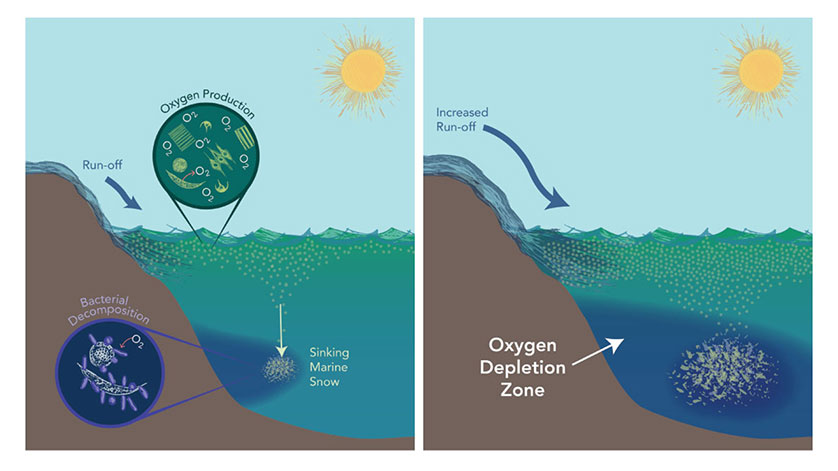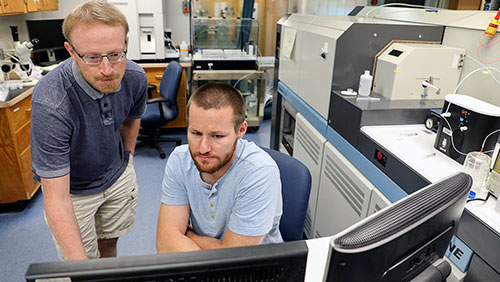New Technique Offers Clues to Measure Ocean Deoxygenation

The living, breathing ocean may be slowly starting to suffocate. More than two percent of the ocean’s oxygen content has been depleted during the last half century, according to reports, and marine “dead zones” continue to expand throughout the global ocean. This deoxygenation, triggered mainly by more fertilizers and wastewater flowing into the ocean, pose a serious threat to marine life and ecosystems.
Yet despite the critical role of oxygen in the ocean, scientists haven’t had a way to measure how fast deoxygenation occurs—today, or in the past when so-called major “anoxic events” led to catastrophic extinction of marine life.
Now, researchers at the Woods Hole Oceanographic Institution, Arizona State University, and Florida State University have, for the first time, developed a way to quantify how fast deoxygenation occurred in ancient oceans. The research was published Aug. 9, 2017, in the journal Science Advances.
 Coauthors Sune Nielsen (left) of Woods Hole Oceanographic Institution and Chad Ostrander from Arizona State University working in the lab. Photo by Matt Barton, Woods Hole Oceanographic Institution
Coauthors Sune Nielsen (left) of Woods Hole Oceanographic Institution and Chad Ostrander from Arizona State University working in the lab. Photo by Matt Barton, Woods Hole Oceanographic Institution
“To date, there haven’t been quantitative tools available to scientists that are capable of accurately measuring the rate at which oxygen depletion happens,” said Sune Nielsen, WHOI scientist and co-author of the paper. “Can the ocean lose half its oxygen in a thousand years? This new tool will help us understand the rate at which deoxygenation was happening in the past, and eventually estimate how far present-day losses might extend into the future.”
Along with warmer sea temperatures and ocean acidification, ocean deoxygenation is yet another threat to marine ecosystems that has scientists concerned. Triggered largely by human activities, expanding pockets of anoxic waters throughout the global ocean are making some fish habitats non-sustainable and having impacts on economically important fisheries.
The ocean’s oxygen supply is being diminished by a number of factors. As runoff from fertilizers and wastewater make their way into the sea, they stimulate growth in phytoplankton, which process the nutrients and convert them to organic matter. When the plankton die and sink, marine microbes consume the organic matter and use up oxygen in the water during the process. Hence, larger phytoplankton growth in surface waters can result in net oxygen loss throughout the ocean depths.
To determine how fast oxygen loss occurs in the ocean over long time scales, the researchers studied ancient seafloor sediments during one of the Earth’s most extreme climate change events, known as Oceanic Anoxic Event 2. It led to a major global extinction of marine animals 94 million years ago when dinosaurs roamed the Earth. The sediments preserve the thallium isotope composition of ancient seawater, which changes depending on the amount of oxygen in the deep ocean at the time they were deposited. The sediments pile up over time, with deeper levels corresponding to times further in the past.
The technique involves measuring isotopes of thallium in the sediments. The relative amount of the heavier thallium isotope increases as levels of deep-marine oxygen diminish. The researchers applied their new technique to analyze the oxygen loss from 94-million-year-old rock samples drilled below the seafloor off the coast of Suriname, South America.
The research began when Chadlin Ostrander (now, a Ph.D. student at Arizona State University) was an undergraduate Summer Student Fellow and Jeremy Owens (now an assistant professor at Florida State University) was a postdoctoral scientist at WHOI, working with Nielsen.
“We dissolved the rocks in our lab,” explained Ostrander, “and then chemically separated everything but the element we needed for analysis: thallium. Then, using mass spectrometry, we were able to measure variations in that element as a proxy for changes in oxygen levels occurring over tens of thousands of years.”
Based on the analysis, the researchers suspect that up to half of the deep ocean had become oxygen-depleted during Oceanic Anoxic Event 2, and remained anoxic for an estimated half-million years before it recovered. More significantly, they were able to draw a parallel between the rate of deoxygenation then and modern trends in oxygen loss now.
“Our results show that marine deoxygenation rates prior to the ancient event were likely occuring over tens of thousands of years, and surprisingly similar to the two percent oxygen depletion trend we’re seeing induced by anthropogenic activity over the last fifty years,” said Nielsen. “We don’t know if the ocean is headed toward another global anoxic event, but the trend is, of course, worrying.”
The new technique may lay the groundwork for projecting future oxygen losses in the ocean. But the scientists said that further insight into past deoxygenation patterns is needed to push their research forward. They plan to analyze additional ancient sediments to investigate what ocean oxygen levels looked like when large marine animals first emerged and how those conditions changed over time.
“At this point, we are only just beginning to understand how oxygen levels in the ocean have changed in the past,” said Ostrander. “But with our new tool, we’ve already learned that one of the most extreme climate events in the deep-time sedimentary record provides an uncomfortably reasonable analogue for possible future ocean deoxygenation and subsequent ecological shifts. We hope to be able to leverage this information to gain visibility into what the short-, medium- and long-term future will bring for oxygen content in the ocean.”
The research was supported by the National Science Foundation, the NASA Exobiology Program, a WHOI Summer Student Fellowship, and an Agouron Postdoctoral Fellowship.

